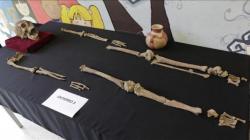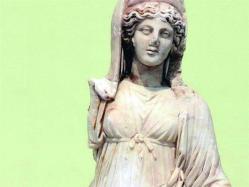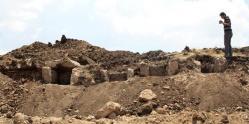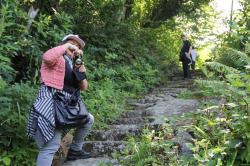INSTITUT SUPERIEUR D'ANTHROPOLOGIE
INSTITUTE OF ANTHROPOLOGY
ONLINE COURSES / COURS A DISTANCE
SUMMER TERM : JULY 2014
REGISTER NOW
EL SALVADOR –  La Esperanza - Une équipe nippo-salvadorienne travaille sur le site de La Esperanza, situé à 90 km au sud-est de la capitale San Salvador, près de la côte de l'Océan Pacifique. Il fut couvert au Classique moyen (entre 500 et 600 ans de notre ère) par les cendres projetées par différentes éruptions volcaniques. Dans une dépêche publiée par l'Agence France Presse, l'archéologue japonais Akira Ichikawa fait état de la découverte de trois individus sous une couche de cendres haute de 2 m. Il s'agit de deux adultes âgés entre 25 et 35 ans et d'un enfant d'environ 9ans.Ce dernier a été retrouvé avec deux billes en argile, situées à hauteur du cou. Deux des corps ont été retrouvés en position allongée fléchie. Des offrandes les accompagnaient, prenant la forme de jarres et de vaisselles en terre cuite peinte de rayures rouges et marron.
La Esperanza - Une équipe nippo-salvadorienne travaille sur le site de La Esperanza, situé à 90 km au sud-est de la capitale San Salvador, près de la côte de l'Océan Pacifique. Il fut couvert au Classique moyen (entre 500 et 600 ans de notre ère) par les cendres projetées par différentes éruptions volcaniques. Dans une dépêche publiée par l'Agence France Presse, l'archéologue japonais Akira Ichikawa fait état de la découverte de trois individus sous une couche de cendres haute de 2 m. Il s'agit de deux adultes âgés entre 25 et 35 ans et d'un enfant d'environ 9ans.Ce dernier a été retrouvé avec deux billes en argile, situées à hauteur du cou. Deux des corps ont été retrouvés en position allongée fléchie. Des offrandes les accompagnaient, prenant la forme de jarres et de vaisselles en terre cuite peinte de rayures rouges et marron.
http://mexiqueancien.blogspot.fr/2014/07/decouverte-des-restes-de-trois.html
TURQUIE -  Simav- A Greek statue was unearthed during an illegal excavation in the western province of Kütahya’s Simav district last April. The statue, which is 610 kg in weight and 2.8 meters in height, is thought to be in the image of the goddess Demeter, from Greek mythology. Recently, the Kütahya Museum Directorate kicked off archaeological excavations in the same area in collaboration with the Simav Municipality, in order to search for other pieces from the statue. The excavations, which have been ongoing for three days, have so far unearthed a cremation center, where the dead people were burned and buried. This center is estimated to date back to the Roman era. Kütahya Museum Director Metin Türktüzün said the excavations were going on an area of 40 square meters, and some more pieces from the Demeter statue had been discovered. “In this area there is a structure with a niche. We found three meters of the wall of this structure, but have not been able to reach the other wall yet … Since treasure hunters caused destruction in the region, we have not been able to identify the entrance yet. We have unearthed a few more pieces of the Greek goddess Demeter. We don’t know the relation of Demeter to this place yet,” Türktüzün said. He added that they thought the structure was a religious site, as they had found candles and burned bones there. “The structure probably dates back to the 2nd and 3rd century. The Demeter statue dates back to this era too, and it was brought here from one of the other nearby ancient cities. As it is a first-class statue, it is not possible that it was made in this region … We also expect to find other pieces of the statue,” Türktüzün said.
Simav- A Greek statue was unearthed during an illegal excavation in the western province of Kütahya’s Simav district last April. The statue, which is 610 kg in weight and 2.8 meters in height, is thought to be in the image of the goddess Demeter, from Greek mythology. Recently, the Kütahya Museum Directorate kicked off archaeological excavations in the same area in collaboration with the Simav Municipality, in order to search for other pieces from the statue. The excavations, which have been ongoing for three days, have so far unearthed a cremation center, where the dead people were burned and buried. This center is estimated to date back to the Roman era. Kütahya Museum Director Metin Türktüzün said the excavations were going on an area of 40 square meters, and some more pieces from the Demeter statue had been discovered. “In this area there is a structure with a niche. We found three meters of the wall of this structure, but have not been able to reach the other wall yet … Since treasure hunters caused destruction in the region, we have not been able to identify the entrance yet. We have unearthed a few more pieces of the Greek goddess Demeter. We don’t know the relation of Demeter to this place yet,” Türktüzün said. He added that they thought the structure was a religious site, as they had found candles and burned bones there. “The structure probably dates back to the 2nd and 3rd century. The Demeter statue dates back to this era too, and it was brought here from one of the other nearby ancient cities. As it is a first-class statue, it is not possible that it was made in this region … We also expect to find other pieces of the statue,” Türktüzün said.
http://www.hurriyetdailynews.com/works-start-to-find-missing-pieces-in-area-of-illegal-excavation.aspx?pageID=238&nID=68838&NewsCatID=375
USA – Fort Laurens - A Revolutionary War-era button and some square nails, likely from the 18th century, are among the artifacts that have been found so far by archaeologists digging at the northeast bastion of Fort Laurens. “We’ve also found some lead, which could be used to produce ammunition,” said Jarrod Burks of Ohio Valley Archaeology, which is conducting the dig for the Ohio Historical Society. In addition to items that may have been used by soldiers during the American Revolution, the archaeologists have found pre-historic flint flakes, spear points and stone tools used by native Americans, he said. “They’re not related to the fort.
”http://www.cantonrep.com/article/20140707/NEWS/140709545
USA – Ree Heights- “The hillside revealed a layer of bones perhaps a foot below the surface, and the bones themselves are perhaps another 18 inches deep,” Lockner said. “I think I stepped it off once and the place where the bones are is about 75 feet long – that’s what’s visible. As that hill moves, it might reveal more.”Lockner and his wife, Candice, haven’t dug into the bones to try to determine what the bones are, but they already have a pretty good idea: bison.In addition, there’s the evidence of what is already known about how prehistoric American Indians used the area. The Lockners ranch on land only a short way west from a bison kill site on the Casey and Jan Deuter ranch that was discovered in the 1960s – a location where prehistoric American Indian people stampeded bison over the sheer face of the hills near the site of present-day Ree Heights.The new bone bed on the family land he ranches may be more evidence, Lockner said, of how American Indians used the Ree Heights terrain in hunting for bison.
http://nativetimes.com/index.php/culture/history/10126-possible-new-bison-kill-site-near-ree-heights
ROYAUME UNI –  Segedunum- Volunteer diggers have uncovered the remains of Roman baths last seen exactly 200 years ago. The team from the community archaeology project WallQuest have found the baths which served the garrison and civilian population at Segedunum fort in Wallsend in North Tyneside. The discovery comes after months of detective work on old maps and records by WallQuest volunteers who pinpointed the site of the former Ship in the Hole pub as being the most likely candidate.
Segedunum- Volunteer diggers have uncovered the remains of Roman baths last seen exactly 200 years ago. The team from the community archaeology project WallQuest have found the baths which served the garrison and civilian population at Segedunum fort in Wallsend in North Tyneside. The discovery comes after months of detective work on old maps and records by WallQuest volunteers who pinpointed the site of the former Ship in the Hole pub as being the most likely candidate.
http://www.thejournal.co.uk/news/north-east-news/roman-baths-discovered-underneath-former-7387645
NEPAL - Manang- A 2,300-yea-old cave has been discovered in Manang district. A combined team of department of archaeology, government of Nepal and United States of America found the historically significant cave. The fact came to light after archaeologists examined the remainings recovered from Kyang cave of remote Fu VDC of the district. The remains were recovered last year. The site lies at an altitude of 3,840 metres above sea level, little above the Khampale residence. With the carbon dating examination of the 8.4 metres long, 1.3 metres brroad and 1.4 metres tall remains, it was verified that it was more than two decades old, said the experts involved in the research. -Though some of the caves found earlier in the Mustang district were said to have been built for human settlement, this cave is said to have been used to bury the dead. Some chips of firewood, clay pots, and pieces of logs along with other carvings belonging to various human activities have been found. Hence, it has been said that the cave might have been used by ancient people. Mohan Singh Lama, an officer of the department said, “We have enough evidences to prove to say that it was used by human beings, but we are yet to confirm whether it was used to live or just to bury the dead.” Earlier, a unique cave culture was discovered at Chokhopani of Mustang in 1996 -
http://www.thehimalayantimes.com/fullNews.php?headline=2%26sbquo%3B300-year-old+cave+found+&NewsID=420510
EGYPTE –  al-Koam al-Ahmar- The Minister of Antiquities and Heritage Mamdouh al-Damaty announced the discovery of the remains of an ancient city dating back to the Roman era, located at a distance of approximately 25 km south of the Rashid's Nile branch in Beheira Governorate. An international joint team between the Ministry of Antiquities and the Italian-Egyptian Center for Restoration and Archaeology surveyed of archaeological area of al-Koam al-Ahmar in Beheira where they discovered the remains of a city under an enormous layer of the Nile silt. Damaty explained that this discovery had a monumental historical importance, especially, as it reflected a lively image of the details of daily life in the Roman era in Egypt as well as revealed the architectural nature of such cities. The discovered city is a distinct model that reflects the mechanisms of urban planning during the Hellenistic era in the Delta, said Damaty, pointing out that the archaeological remains discovered contribute to the identification of more of the architectural elements in the region, specifically in the sites of Koam al-Ahmar and Koam al-Wasat, and adds to former discoveries such as the large ancient Roman bathhouse, located in the same region. The minister added that the survey conducted revealed the existence of many facilities surrounding a huge building that appeared in a rectangular shape, a building that was likely used in the past for either religious or administrative purposes, Damaty said. Damaty praised the research experience where the latest techniques of geophysical, topographic and magnetic surveys in addition to aerial photography were used by an international team of archaeologists. The initial signs suggest that the discovered city belongs to the late period of the Pharaonic families, and still needs more studies and specialized research to reach all the historical archaeological details and facts, said member of the discovery team Mohamed Kenawy.
al-Koam al-Ahmar- The Minister of Antiquities and Heritage Mamdouh al-Damaty announced the discovery of the remains of an ancient city dating back to the Roman era, located at a distance of approximately 25 km south of the Rashid's Nile branch in Beheira Governorate. An international joint team between the Ministry of Antiquities and the Italian-Egyptian Center for Restoration and Archaeology surveyed of archaeological area of al-Koam al-Ahmar in Beheira where they discovered the remains of a city under an enormous layer of the Nile silt. Damaty explained that this discovery had a monumental historical importance, especially, as it reflected a lively image of the details of daily life in the Roman era in Egypt as well as revealed the architectural nature of such cities. The discovered city is a distinct model that reflects the mechanisms of urban planning during the Hellenistic era in the Delta, said Damaty, pointing out that the archaeological remains discovered contribute to the identification of more of the architectural elements in the region, specifically in the sites of Koam al-Ahmar and Koam al-Wasat, and adds to former discoveries such as the large ancient Roman bathhouse, located in the same region. The minister added that the survey conducted revealed the existence of many facilities surrounding a huge building that appeared in a rectangular shape, a building that was likely used in the past for either religious or administrative purposes, Damaty said. Damaty praised the research experience where the latest techniques of geophysical, topographic and magnetic surveys in addition to aerial photography were used by an international team of archaeologists. The initial signs suggest that the discovered city belongs to the late period of the Pharaonic families, and still needs more studies and specialized research to reach all the historical archaeological details and facts, said member of the discovery team Mohamed Kenawy.
http://www.egyptindependent.com//news/ancient-roman-city-discovered-under-nile-delta-silt
TURQUIE –  Sandıklı - Five sarcophagi approximated to be about 6,000 years old were uncovered during an excavation at a stone quarry in the western province of Afyonkarahisar's Sandıklı district. According to media reports, workers came across the sarcophagus while using heavy machinery to excavate a quarry. Upon discovering a sarcophagus, the workers immediately informed the Afyonkarahisar Archeology Museum about the historical items they had accidentally found. The museum's archeologists were then able to uncover four more sarcophagi during an excavation they conducted. Apart from the sarcophagi, the archeologists also found pieces of glass, plates and bones during the excavation. The museum will preserve the artifacts.
Sandıklı - Five sarcophagi approximated to be about 6,000 years old were uncovered during an excavation at a stone quarry in the western province of Afyonkarahisar's Sandıklı district. According to media reports, workers came across the sarcophagus while using heavy machinery to excavate a quarry. Upon discovering a sarcophagus, the workers immediately informed the Afyonkarahisar Archeology Museum about the historical items they had accidentally found. The museum's archeologists were then able to uncover four more sarcophagi during an excavation they conducted. Apart from the sarcophagi, the archeologists also found pieces of glass, plates and bones during the excavation. The museum will preserve the artifacts.
http://www.todayszaman.com/news-351877-five-6000-year-old-sarcophagi-unearthed-in-western-turkey.html
TURQUIE –  Salipazari - An ancient road believed to date back to the Iron Age and featuring rock-carved stairs has been discovered in the northern province of Samsun’s Salıpazarı district. The director of Samsun’s Provincial Directorate of Culture and Tourism, Yüksel Ünal, said that detailed works would be carried out along the 40-meter-long ancient road, located in the Yeşilköy Kayadibi neighborhood of Samsun. He said the stairs had been damaged over time, adding that they would also start working to ensure the area becomes a protected site.
Salipazari - An ancient road believed to date back to the Iron Age and featuring rock-carved stairs has been discovered in the northern province of Samsun’s Salıpazarı district. The director of Samsun’s Provincial Directorate of Culture and Tourism, Yüksel Ünal, said that detailed works would be carried out along the 40-meter-long ancient road, located in the Yeşilköy Kayadibi neighborhood of Samsun. He said the stairs had been damaged over time, adding that they would also start working to ensure the area becomes a protected site.
http://www.hurriyetdailynews.com/ancient-road-discovered-in-black-sea-province-of-samsun-.aspx?pageID=238&nID=68784&NewsCatID=375
INDE – x Kalasipalya - The historical Tipu Sultan’s Armoury at Kalasipalya here, which was an integral part of the wars fought by the 19th century ruler, is now in a shambles and has turned into a dumping site. Neither the Archaeological Survey of India (ASI) nor the Department of Archaeology, Museums and Heritage, Government of Karnataka (DAMH) has been conserving this heritage site. Heaps of garbage can be seen dumped inside and outside the armoury site. There is also a temporary shed inside, with some men taking shelter in it. There is no proper entrance but just a makeshift wooden gate.
Kalasipalya - The historical Tipu Sultan’s Armoury at Kalasipalya here, which was an integral part of the wars fought by the 19th century ruler, is now in a shambles and has turned into a dumping site. Neither the Archaeological Survey of India (ASI) nor the Department of Archaeology, Museums and Heritage, Government of Karnataka (DAMH) has been conserving this heritage site. Heaps of garbage can be seen dumped inside and outside the armoury site. There is also a temporary shed inside, with some men taking shelter in it. There is no proper entrance but just a makeshift wooden gate.
http://www.deccanherald.com/content/418154/tipu-armoury-site-kalasipalya-lies.html